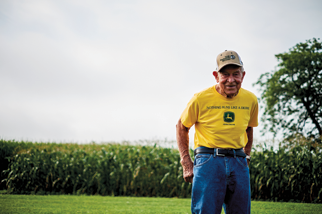From Field to Chip
Who grows the corn in your Shagbark Seed & Mill chips? His name is Chris Clinehens, a third-generation farmer and father of two who farms with his daughter, Ginger; son, Chet; and wife, Kim, in Maplewood, Ohio. Chris’s dad, Gerald, also runs the farm at 90 years old with hands that show the wear and tear of farming and a stature half the size of Chris, perfect for swimming in between the tight rows of certified organic corn, cutting weeds.
The place where they foster their 200 acres of farmland used to be a dairy farm when Chris was little. He started working the farm with his dad when he was 8 years old. In 1994 Chris turned the farm over to organic grain and hasn’t looked back.
“Organic farming is a risk,” Chris says as we stand at the edge of his cornfield looking at weeds and talking about water. Chris doesn’t have an irrigation system and waits for rain. He mentions how this summer he’s watched “spotty” rainstorms descend on the farm next door while his fields remain dry. When I ask him if that’s normal, he admits it seems like it’s getting worse.
The surrounding farmland, with the exception of a cousin who grows non-GMO corn behind Chris’s farm, is all conventional crop. It’s a true maze of cornfields, one after the other looking the same as the next. You could get lost out there in the corn (which I did on the way home and got stuck behind a Amish buggy) as the wind shuttles through and makes the beautiful sound of corn stalks rustling under the sun.
If you’ve ever had the pleasure of growing corn, you know it is a magical process. It has been said that for Native Americans, every part of the plant is sacred, and that corn, or maize, is the staple crop for indigenous food communities in the Americas. The corn plant embodies a mythology all its own. And Chris has a sense of this— ”the plant has a mind of its own,” he says. From the single kernel of a seed to the first sign of a stalk, from the moment you notice tassels coming up and corn pollen raining down, to that first ear of corn, and, oh my, when the corn silks start to appear, it makes for a seductive summer, if you’re a lover of plants.
And Chris is one—gentle, bright eyed, full of good humor and humility, all characteristics he’s passed on to his daughter, Ginger, who will one day take over the farm with her brother, Chet. He shows me his weed hook and how he twists it just so to pull out invaders like horseweed that grow higher than the corn sometimes. It takes three months of planting for the corn crop, cultivating the soil and then the hand weeding; this year they started in early May. They use traditional planting equipment done in six rows at a time, then wait and work all summer until August, when they take a break and pray for rain. Then, come October, the family will harvest the corn for the year, storing it in grain bins into the winter. The Clinehens produce 4,000 bushels of corn a year for Shagbark.
Shagbark and the Clinehens move the corn crop by way of semi-trucks that carry the inventory down to Athens, where it is cleaned, milled and sent to the tortilla factory. As a continuation of our look into what makes Shagbark tick, we’ll feature more on this last stage in our winter issue.
And speaking of winter, did you know you could keep your sweet corn, husk and all, in the freezer to enjoy when it snows? Chris ends our time together with a tip: Freeze the sweet corn on the cob with the husks on. When ready to eat, put them in cold water then bring to a boil (with the shucks still on). Let the corn boil as you would when cooking it in summer then remove and run cold water over again and remove shucks. We have yet to attempt one farmer’s approach to cooking sweet corn, but if there were ever a farmer to trust on this one, I’d place all my bets on Chris.
“Nature,” he says, “she makes the rules.” It’s because of this humility that he, along with Ginger, Kim, Chet and Gerald, is among those unsung heroes of our country, preserving traditions that created the foundation for the backbone of America. Know that when you buy a bag of Shagbark corn chips you’re supporting a legacy of organic farming and a way of being in the world that is becoming silenced. And it’s up to us to continue to tell the story so the Clinehens can continue to grow the corn.








